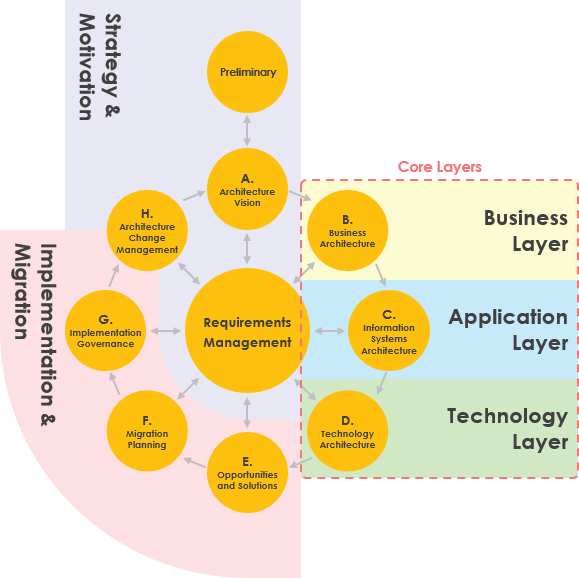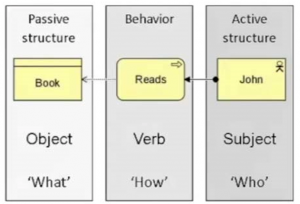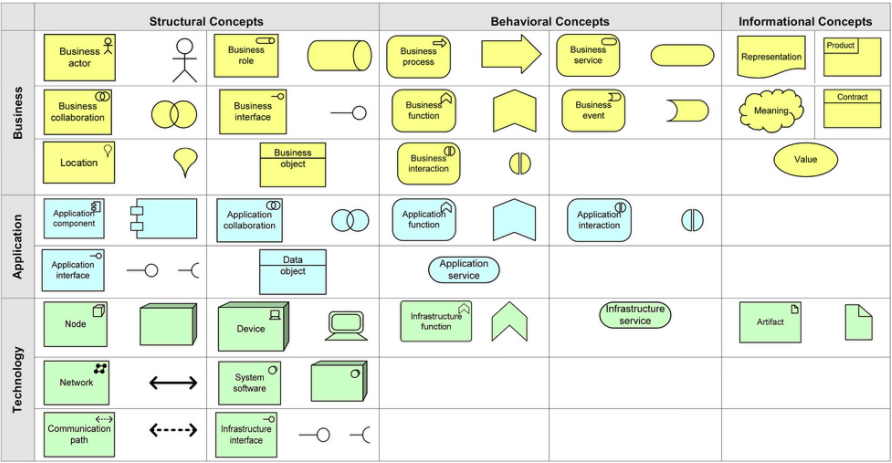A key challenge in the development of Enterprise Architecture is to strike a balance between the specificity of languages for:
- Individual architecture domains
- A very general set of architecture concepts (Business, Application and Technology)
- A set of inter-related entities that can reflects a view of systems

The ArchiMate Core Fraemwork
The ArchiMate core language defines a structure of generic elements and their relationships, which can be specialized in different layers. Three layers are defined within the ArchiMate core language as follows:
1. The Business Layer depicts business services offered to customers, which are realized in the organization by business processes performed by business actors.
2. The Application Layer depicts application services that support the business, and the applications that realize them.
3. The Technology Layer depicts technology services such as processing, storage, and communication services needed to run the applications, and the computer and communication hardware and system software that realize those services. Physical elements are added for modeling physical equipment, materials, and distribution networks to this layer.
Elements and Relationships in Different Lyaers
The general structure of models within the different layers is similar. The same types of elements and relationships are used, although their exact nature and granularity differ.
Layering Framework
ArchiMate defines three layers – Business, Application, and Technology – based on specializations of the core concepts . A layered view provides a natural way to look at service-oriented models. The higher layers make use of services that are provided by the lower layers. In alignment with service-orientation in between different layers, the most important relationship between layers is represented by:
- Serving relationship which shows how the elements in one layer are served by the services of other layers. (Note, however, that services need not only serve elements in another layer, but also can serve elements in the same layer.)
- Realization relationship which shows elements in lower layers may realize comparable elements in higher layer
For example:
- a “data object” (Application Layer) may realize a “business object” (Business Layer)
- an “artifact” (Technology Layer) may realize either a “data object” or an “application component” (Application Layer).
Aspects of elements
The conceptual framework shows the layers combined with three aspects (passive structure, behavior and active structure) as a way to organize modeling from different viewpoints.
The aspects of the core, as defined by the three types of element vertically, associated with the layers identified horizontally, make up a framework of nine cells, as illustrated shown in the Figure below. This is known as the ArchiMate Core Framework.

Active Structure represents the structural elements (the business actors, application components, and devices that display actual behavior).
Behavior represents the behavior (processes, functions, events, and services) performed by the actors.
Passive Structure represents the objects on which behavior is performed.
Example: Aspects correspond to a Subject-Verb-Object of sentences pattern:

It is important to realize that the classification of concepts based on aspects and layers, is only a global one. It is impossible to define a strict boundary between the aspects and layers, because concepts that link the different aspects and layers play a central role in a coherent architectural description. For example, running somewhat ahead of the later conceptual discussions, (business) functions and (business) roles serve as intermediary concepts between “purely behavioral” concepts and “purely structural” concepts.
You can map the concepts to the framework as shown below:
Here is the ArchiMate Core Framework Elements:

Other ArchiMate Resources:
- The Open Group Certified ArchiMate 3 Tool
- What is ArchiMate?
- ArchiMate diagram
- How to Draw ArchiMate 3.0.1 Diagram?
- Understanding ArchiMate Viewoints Mechanism
- ArchiMate Viewpoint Guide